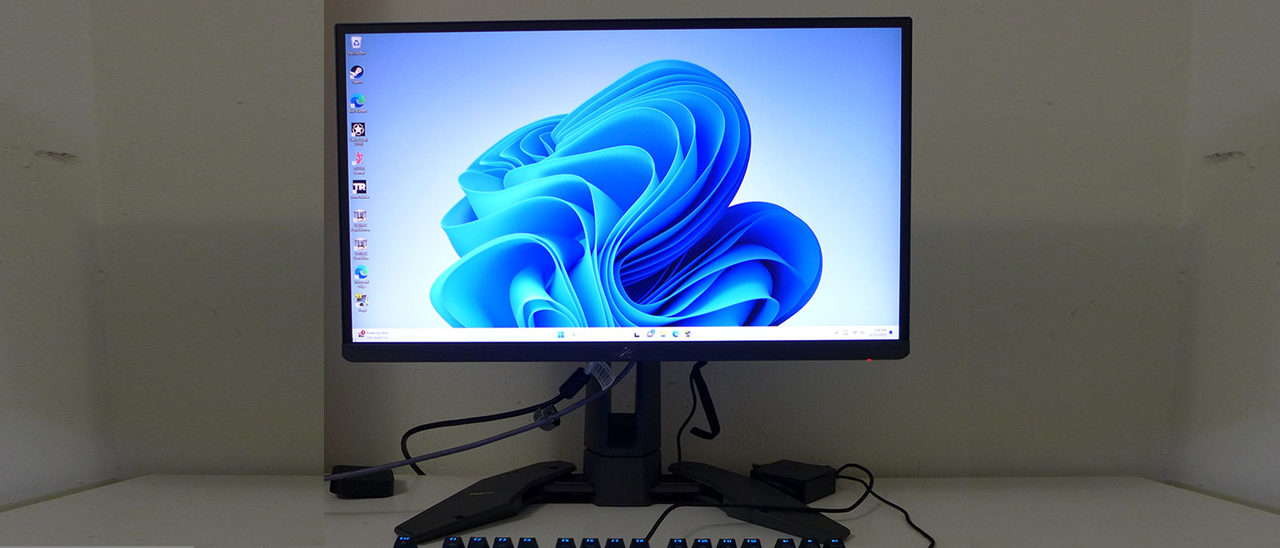Why you can trust Tom's Hardware
Our HDR benchmarking uses Portrait Displays’ Calman software. To learn about our HDR testing, see our breakdown of how we test PC monitors.
Though the PG248QP is focused on speed, its HDR performance has not been overlooked. It’s rated for DisplayHDR 400, and it employs dynamic contrast via backlight field dimming to increase dynamic range. With a wide color gamut, it’s poised to deliver impactful HDR.
HDR Brightness and Contrast
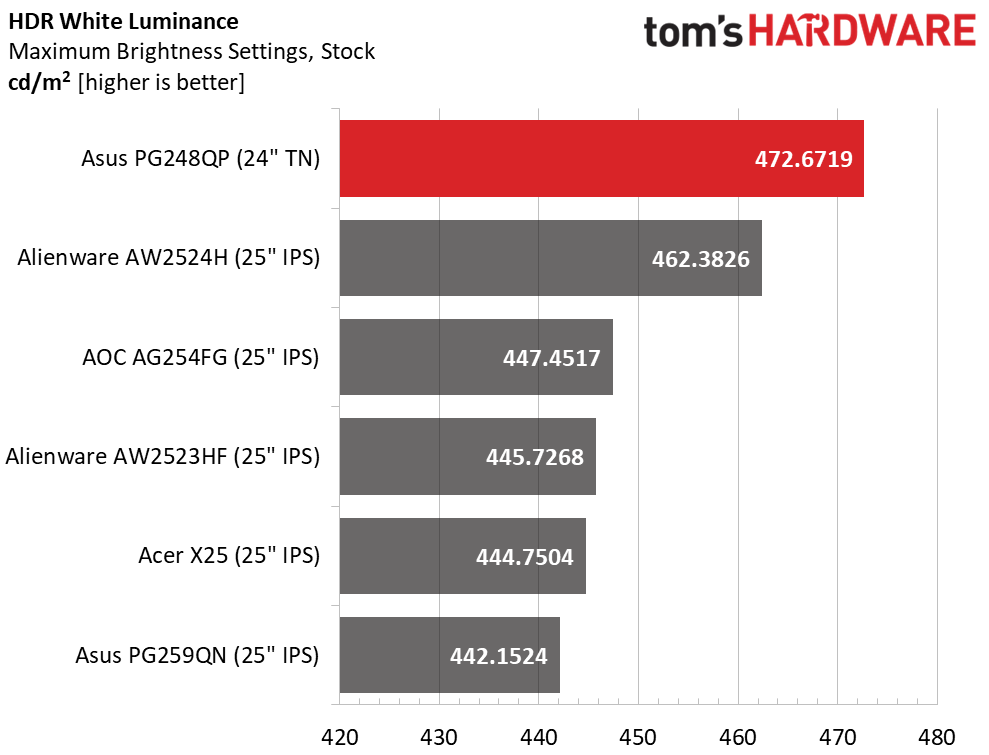

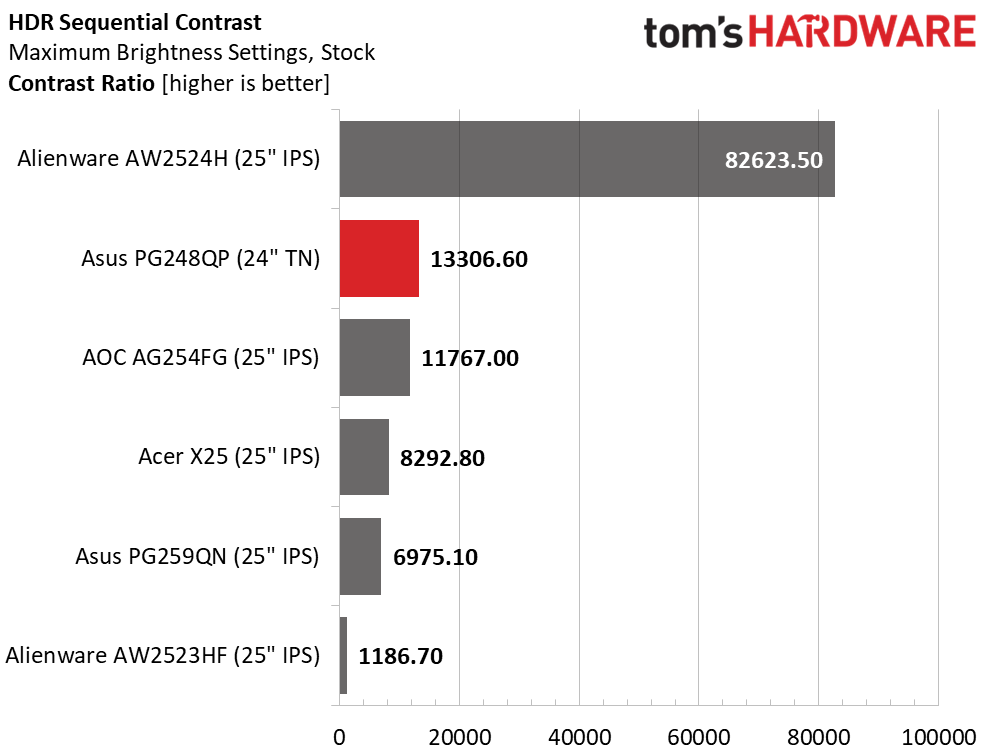
I found a little more juice in the PG248QP’s HDR mode with 472 nits peak output. That overhead is useful when you want to engage the backlight strobe (ULMB 2), which cuts brightness. With variable backlight turned on, black levels are very low at just 0.0355 nit. The resulting contrast is a satisfying 13,306.6:1. This beats all comers except the AW2524H, which has a more aggressive dimming feature. Visually, the PG248QP’s HDR pops with bright highlights and true blacks rife with detail. Add in the extra color saturation and you have one of the better HDR monitors I’ve seen.
Grayscale, EOTF and Color
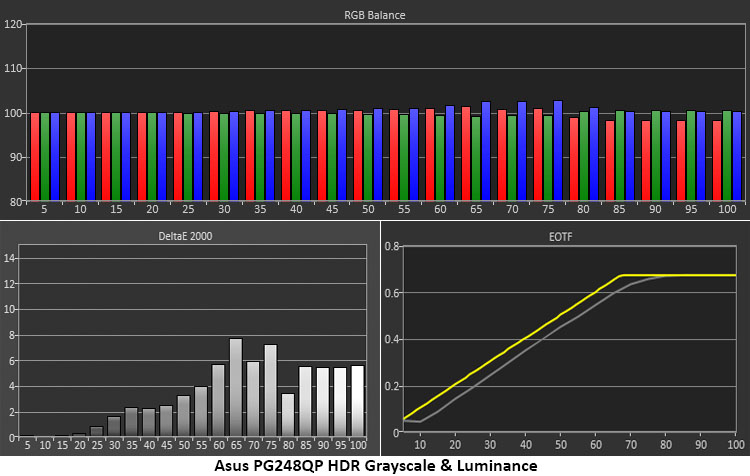
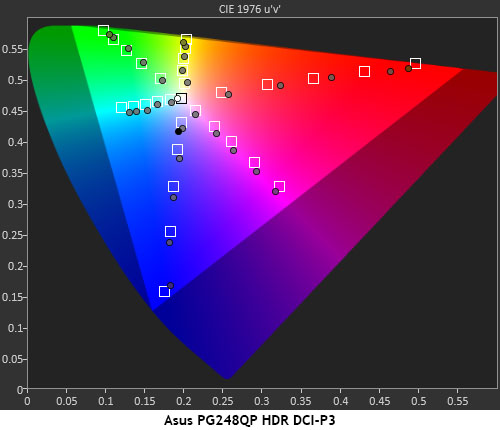
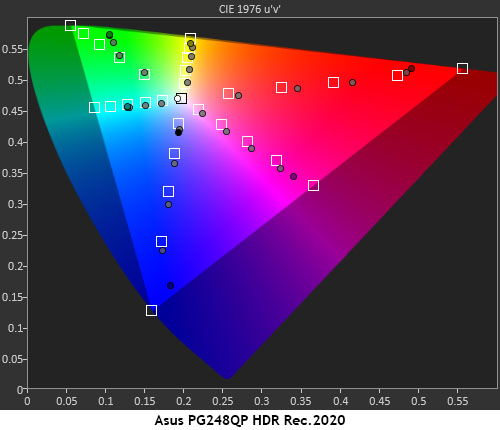
The PG248QP retains access to all its HDR picture modes, but Racing is still the best choice. Brightness steps above 55% are slightly cool in tone, but this is hard to spot in actual content. Luminance tracking is a little darker than reference, but I had no complaints when viewing real-world material. Most HDR games have their own tweaks that you can use to bring out shadow and highlight detail. The PG248QP won’t require much help there.
HDR color is richly saturated with hues that are very close to their targets. Most colors are slightly over-saturated, which is fine visually. Green is a tad under; typical performance of wide gamut displays. The same behavior can be observed in the Rec.2020 test, where most targets are over-saturated until the PG248QP runs out of color near the gamut perimeter. This is excellent performance.
Test Takeaway: You’re not buying the PG248QP for its HDR prowess, but Asus has delivered excellent quality anyway. With a nice bump in contrast and a wide color gamut, its HDR is better than that of other super-fast screens. In this metric, it is clearly best in class.
MORE: Best Gaming Monitors
Get Tom's Hardware's best news and in-depth reviews, straight to your inbox.
MORE: How We Test PC Monitors
MORE: How to Buy a PC Monitor
MORE: How to Choose the Best HDR Monitor

Christian Eberle is a Contributing Editor for Tom's Hardware US. He's a veteran reviewer of A/V equipment, specializing in monitors. Christian began his obsession with tech when he built his first PC in 1991, a 286 running DOS 3.0 at a blazing 12MHz. In 2006, he undertook training from the Imaging Science Foundation in video calibration and testing and thus started a passion for precise imaging that persists to this day. He is also a professional musician with a degree from the New England Conservatory as a classical bassoonist which he used to good effect as a performer with the West Point Army Band from 1987 to 2013. He enjoys watching movies and listening to high-end audio in his custom-built home theater and can be seen riding trails near his home on a race-ready ICE VTX recumbent trike. Christian enjoys the endless summer in Florida where he lives with his wife and Chihuahua and plays with orchestras around the state.
-
javiindo Now you need to find a game you can play at 540 hz. Even with dlss3 it's not easy and to use dlss3 initroduce some latency .Reply -
The Historical Fidelity Not to be nit picky but color gamut is normally just a variable of back light and color filter quality. High Color Rendering Index leds emit a higher percentage of the visible light spectrum as well as higher light intensity in the areas of the visible spectrum that normal leds have a hard time producing in quantity (IE: deep reds, and cyan), and color filters can be made to inhibit color cross-talk and optimize polarization states, so I’m confused why sacrificing color gamut is typically correlated to high refresh rate when it does not affect refresh rate in any way?Reply -
helper800 If i cared about anything past 240hz, I would wait for a monitor such as the one talked about in this article. LG claims to have achieved 480hz OLED panels at 2560x1440. OLEDs motion clarity as a baseline has been the highest among panel technologies in my experience. My 120hz CX OLED from LG looks better in motion handling that my own 165hz IPS display from viewsonic. Th OLED CX also looks better, imo than my friends non-OLED 240hz samsung panel. If you are going to spend nearly 1000 dollars, imo its better to wait for a bigger leap in tech like the aforementioned LG panels.Reply -
Phaaze88 Folks already achieve ultra high fps on monitors that can't display it, so why should they spend money on products like this?Reply
/S -
UnforcedERROR Reply
This is a monitor almost exclusively for games like CS2 and Valorant, which aren't hard to run at high FPS. A 4090 at 1080p will get you 800 FPS in Valorant, for instance. A good CPU + GPU will get you the same in CS2 (Source engine is CPU-reliant). It's for the people who want to reduce input latency as low as possible, and it's a fairly niche space.javiindo said:Now you need to find a game you can play at 540 hz. Even with dlss3 it's not easy and to use dlss3 initroduce some latency .
That said, I think it's interesting this article credits the VG248 as the monitor that ushered in fast refresh monitors, considering the XL2420T beat it to market by a year, even if it was only 120hz. I'd argue that was the first real high refresh LCD monitor, and I remember it changing the competitive FPS landscape a lot at the time. -
Tom Sunday ReplyPhaaze88 said:Folks already achieve ultra high fps on monitors that can't display it, so why should they spend money on products like this?
I can appreciate the mentioning that video processing and speed here are on the next level. I only play three owned games, (Fallout 4, Dishonored and Wolfenstein New Order) will these at anything even close to the processing speed and image smoothness as advertised give me more of a real-live sensation and gaming WOW factor never experienced before? Like repairing the roads and roofs in Sanctuary faster and improving NPC fluidity? Of course true enthusiast gaming today is usually played on a 32-34 inch monitors for all the good reasons. Not customarily on a 24 inch screen! Then today what professional would do actual work on a 24-inch screen? Finally who would buy such monitor and then for almost a WTF $900? -
CmdrShepard This is the lamest and most deceptive review I ever read on Toms Hardware ever since the site was created.Reply
Why? Because it left out one of the most important tech spec items -- viewing angles.
Viewing Angle (CR≧10) : 170°/ 160°
TN panels are fast sure, but they are trash when it comes to viewing angles.
With 160 degrees vertical viewing angle you just need to slump in your chair a bit, and what you will see on the screen will no longer have any resemblance of the original color and contrast as when you were looking at it dead center at a 90 degrees angle.
Also, the claim is made in this "review" (more like a paid ad!) that this monitor covers over 89% of DCI P3 color space while the tech specs on ASUS website do not mention DCI P3 support anywhere -- they claim 125% sRGB which is a pure marketing garbage. 25% more than sRGB? in which direction on the color chart?. I checked the ICM profile using ICC Profile Inspector and it turns out only in R and G direction (B is well within sRGB if not a bit less) I doubt that monitor even has a DCI P3 color setting in the menu.
The author should be ashamed for writing such low quality content.
